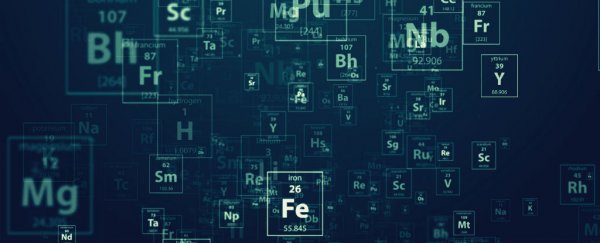Mechanical engineer Asegun Henry is figuring out the unique 'musical' signatures of every element on the period table to give scientists a new way of analysing their constantly shifting molecular structure - as well as science nerds like us the chance to actually hear how different arrangements of molecules and chemical bonds can behave.
"My hope is that it will be an interesting tool to teach the periodic table, but also to give people some notion about the idea that the entire Universe is moving around and making noise," Henry told Jennifer Ouellette from Gizmodo. "You just can't hear it."
So why does every chemical element have a unique musical signature? We all know that everything in the Universe is made up of atoms, and these atoms are in a constant state of motion. Depending on the speed at which these atoms are vibrating within the bonds between larger molecules, you'll get a solid, liquid, gas, or plasma.
These vibrations - or 'waves' - determine the specific properties of an element, such as its density and thermal conductivity, so the better our understanding of how atoms are zipping around, the more we'll know about the capabilities of a particular element.
"How the energy of the interaction changes with respect to the distance between the molecules dictates a lot of the physics," said Henry, who's putting together the catalogue of musical signatures for elements at Georgia Tech.
"We have to slow down the vibrations of the atoms so you can hear them, because they're too fast, and at too high frequencies," he adds. "But you'll be able to hear the difference between something low on the periodic table and something like carbon that's very high. One will sound high-pitched, and one will sound low."
The idea is based on the fact that, in past studies, scientists have discovered key properties of elements by employing different senses. The movements of molecules within an element can sometimes be so subtle or so short-lived, you'll never spot them just by looking at the visual data. A slight "ping" or a change in tone, however, could make all the difference.
While it might sound like a fun little project, it's actually a time-tested technique that was used in a project at CERN called LHCSound to analyse the data from particle collisions, which allowed physicists to detect subatomic particles by ear.
And Henry has even used it to identify new properties in polymers that didn't show up in computer models and simulations of atomic vibrations.
Jennifer Ouellette explains at Gizmodo:
"The simulated polymer becomes thermally superconductive - that is, capable of transporting heat with no resistance, much like the existing class of superconducting materials that conduct electricity without resistance (albeit at very low temperatures). …
Henry and [graduate student, Wei] Lv successfully identified three vibrational modes out of all those thousands that were responsible for the phenomenon. But the usual analysis techniques - like plotting the amplitudes of the modes over time in a visual graph - didn't reveal anything noteworthy.
It wasn't until they decided to sonify the data that they pinpointed what was going on. This involved mapping pitch, timbre, and amplitude onto the data to translate it into a kind of molecular music."
Henry has published his sonification work in the Journal of Applied Physics, and has applied for a National Science Foundation grant to turn his catalogue into an app so we can not only hear the musical signatures, we can also make our own.
In the meantime, you can listen to the 'sound' of crystalline silicon below, and head to Gizmodo, where you can hear the difference between divergent bonds, covalent bonds, and the two together. There's a whole Universe out there to explore, and this time, we won't be needing our eyes.
